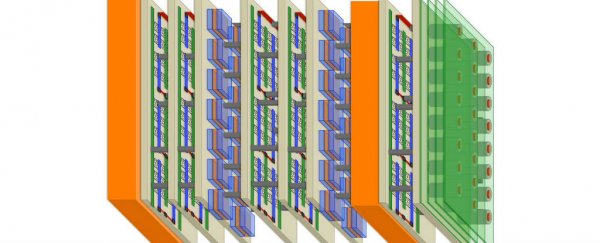Engineers in the US have invented a new computer chip that replaces the silicon in conventional chips with nano-materials that can be stacked, changing the landscape from a resource-heavy single-storey layout to a more efficient 'skyscraper' approach.
Their new multi-layer chip, called N3XT, is designed to break data bottlenecks by laying processors and memory chips on top of each other like floors in a skyscraper, rather than side by side. "When you combine higher speed with lower energy use, N3XT systems outperform conventional approaches by a factor of a thousand," says one of the researchers, H. S. Philip Wong from Stanford University.
If you think about current computer systems, they're arranged just like a sleepy suburb dominated by single-storey houses. The processors and silicon memory chips are arranged next to each other, which means a whole lot of space is being taken up by a single device.
This also means that the digital signals often have to travel across relatively long distances, which not only wastes processing time and energy, it risks bottlenecking, which occurs when a lot of data is trying to travel across the same circuit.
But what if computer systems could be built more like a city, filled with super-efficient skyscrapers that could fit more processors and chips into tinier spaces, with less distance between them? That's the concept behind the N3XT (Nano-Engineered Computing Systems Technology), and while this certainly isn't a new idea, Wong and his team have figured out how to actually make it work.
The problem with stacked computer chips in the past has been silicon. It works great in our current computer systems, but because it has to be heated to about 982ºC (1,800ºF) during manufacture, it's virtually impossible to stack silicon chips without the one on top damaging the one on the bottom.
The best we have right now are three-dimentional, or 'stacked', chips that are composed of two silicon chips, made separately, and then connected by a few thousand wires. That might seem like a lot of wires, but relatively speaking, it's not many at all, which means a lot of energy is needed to push the data from one chip to another.
Instead, the researchers at Stanford decided to build their stacked chips by replacing conventional transistors with carbon nanotube transistors (CNTs). These are not only faster than silicon transistors, but because they don't require such high temperatures during manufacture, they can also be layered between memory chips without causing any damage.
The team also replaced existing silicon chips with what's known as resistive random-access memory, or RRAM, which uses tiny jolts of electricity to switch memory cells between the binary states of zero and one. Millions of devices called vias are used to connect each RRAM and CNT layer like tiny electronic 'elevators' that allow data to travel over much smaller distances than traditional circuits, and thermal cooling layers are installed between the layers to ensure that the heat they generate doesn't build up and cause long-term degradation.
The team demonstrated a four-layer prototype made from two layers of RRAM memory and two layers of CNTs at the 2014 International Electron Devices Meeting, and in an upcoming paper in the IEEE Computer journal, describe how they've run simulations showing how their more advanced skyscraper approach is 1,000 times more efficient than conventional computer systems.
They now just have to convince the industry to invest in the huge infrastructure change that would be needed to step away from silicon and towards a potentially much more efficient system, but they say the pay-off would be massive. And of course, a working prototype - not just simulations - would be required to really prove the capabilities of N3XT.
"There are huge volumes of data that sit within our reach and are relevant to some of society's most pressing problems from health care to climate change, but we lack the computational horsepower to bring this data to light and use it," said one of the team, computer scientist Chris Re. "As we all hope in the N3XT project, we may have to boost horsepower to solve some of these pressing challenges."
